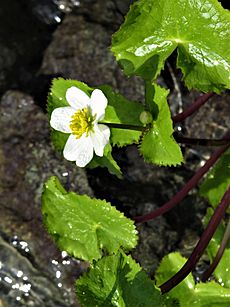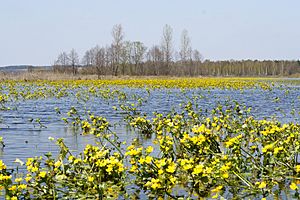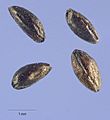Caltha palustris facts for kids
Quick facts for kids Caltha palustris |
|
|---|---|
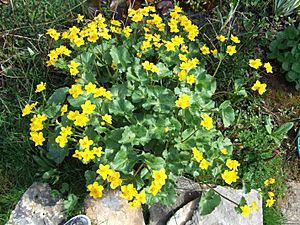 |
|
| Scientific classification | |
| Genus: |
Caltha
|
| Species: |
palustris
|
| Varieties | |
| Synonyms | |
|
Trollius paluster E.H.L.Krause |
|
The Caltha palustris, also known as marsh-marigold or kingcup, is a small to medium-sized plant. It's a perennial herb (meaning it lives for more than two years and has soft stems). This plant belongs to the buttercup family. You can find it naturally in wet places like marshes, fens, ditches, and damp woodlands. It grows in temperate areas of the Northern Hemisphere. The marsh-marigold usually blooms between April and August. Sometimes, you might see flowers at other times of the year too.
Contents
What Does It Look Like?
The marsh-marigold is a plant that can grow from 10 to 80 centimeters (about 4 to 31 inches) tall. It has no hair on its stems and leaves, and its parts are quite fleshy. It's a perennial plant, which means it lives for several years. In autumn, the plant dies back, but its buds stay alive near the surface of the wet soil, ready to grow again next spring.
The plant has many roots, each about 2–3 millimeters thick, that spread out a lot. Its flowering stems are hollow and stand upright or lean sideways. The leaves grow in a circle close to the ground, called a rosette. Each leaf has a long stem, about four times longer than the leaf blade itself. The leaf blade is shaped like a kidney or a heart, measuring 3–25 cm long and 3–20 cm wide. Its edges can be wavy, toothed, or sometimes smooth. When the leaves are young, they are protected by a thin, papery cover.
Flowers
The marsh-marigold usually has several flowering stems, which can be up to 80 cm long. These stems hold many flowers, usually between four and six, but sometimes as few as one or as many as twenty-five. Each flower is about 4 cm (1.6 inches) across.
The flowers have four to nine (most often five) petal-like parts called sepals. These sepals are brightly colored, usually yolk-yellow, but can also be white or magenta. They are shaped like an upside-down egg and are about 1.75 cm long. Marsh-marigolds don't have true petals or nectar-producing parts.
Inside the sepals, there are many stamens (the male parts of the flower), usually between fifty and one hundred twenty. These stamens have flat yellow stalks and yellow pollen. In the center, there are five to twenty-five separate, flat, yellow to green carpels (the female parts). Each carpel has a two-lobed tip called a stigma and many tiny seedbuds. After the flower blooms, these carpels turn into funnel-shaped fruits called follicles. Each follicle is about 0.75–2 cm long and contains seven to twenty small, brown to black seeds.
Plant Names
How It Got Its Name
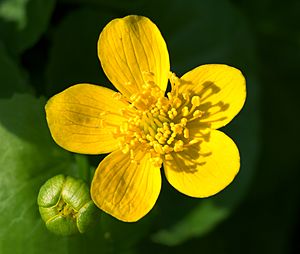
The first widely accepted description of this plant was in 1700. However, the famous scientist Carl Linnaeus officially named it Caltha palustris in 1753. This is the name we still use today.
The name Caltha comes from an Ancient Greek word meaning "goblet" or "cup." This probably refers to the cup-like shape of the flower. The second part of the name, palustris, is Latin for "of the marsh," which tells us where this plant likes to grow.
In the UK, people call Caltha palustris by many different names, like marsh marigold and kingcup. Other names include brave bassinets, crazy Beth, horse blob, and water boots. The name "marigold" comes from medieval times. People used to put these flowers in churches at Easter to honor the Virgin Mary, so they called them "Mary gold." In North America, it's sometimes called cowslip, but that name usually refers to a different, smaller plant called Primula veris.
In Books and Stories
The marsh-marigold has appeared in many famous books and poems.
For example, William Shakespeare mentioned it in his play Cymbeline:
- Winking Marybuds begin
- To open their golden eyes
It's also in Charlotte Brontë's book Shirley:
- They both halted on the green brow of the Common: they looked down on the deep valley robed in May raiment; on varied meads, some pearled with daisies, and some golden with king-cups: to-day all this young verdure smiled clear in sunlight; transparent emerald and amber gleams played over it
And in Thomas Hardy's poem 'Overlooking the River Stour':
- Closed were the kingcups; and the mead/Dripped in monotonous green,/Though the day's morning sheen/Had shown it golden and honeybee'd.
There's even a children's book called Kingcup Cottage by Racey Helps that features this plant.
In Latvia, the marsh-marigold is called gundega. This word is also a girl's name and means "fire." It comes from two words: uguns ("fire") and dega ("burned"). This name might refer to how some people feel a burning sensation if the plant's sap touches their skin.
Different Kinds of Marsh-Marigold
The marsh-marigold is a very diverse plant, meaning it can look quite different depending on where it grows. Scientists have recognized several varieties:
- Common Marsh-Marigold (C. palustris var. palustris): This is the most common type, with yellow sepals. Its pollen is usually tricolpate (a type of pollen grain). It doesn't root from its stems.
- Creeping Marsh-Marigold (C. palustris var. radicans): This type is smaller and has stems that root at the nodes (where leaves join the stem) after flowering. It's often found at the northern edges of the plant's range.
- White Marsh-Marigold (C. palustris var. alba): This variety has white sepals. It grows in high mountain areas like Afghanistan, Pakistan, and the Himalayas.
- Magenta Marsh-Marigold (C. palustris var. purpurea): This type has magenta-colored sepals. It's found in the eastern Himalayas at very high altitudes.
Many nurseries sell different types of marsh-marigolds for gardens. Some have single flowers, while others have beautiful double flowers, like the "Flore Pleno" variety, which has won an award for being a great garden plant.
Where It Grows and Who Visits It
The marsh-marigold loves places with lots of oxygen in the water near the soil surface. It prefers rich soil but doesn't like too much fertilizer. It also avoids salty water. You often see it where water seeps out of the ground, especially if there's iron in the water. This iron can make the water look rusty.
You can find marsh-marigolds growing among reeds at the edges of lakes and rivers. They also grow in forests that are often flooded and always moist, like black alder coppices. When they bloom, they often stand out because of their bright colors. They used to be common in wet meadows, but now they are mostly found in ditches due to changes in farming.
In Europe, a tiny moth called the marsh-marigold moth (Micropterix calthella) eats the pollen from these flowers. Its caterpillars also feed on the plant. Another insect visitor is the leaf beetle Prasocuris phellandrii, which eats the sepals. In the USA, other leaf beetles like Plateumaris nitida and Hydrothassa vittata can be found on marsh-marigolds.
How Flowers Get Pollinated
Marsh-marigold flowers produce both nectar and a lot of pollen. This attracts many insects. Hoverflies are often the main pollinators. In Canada, many different insects visit the plant, including beetles, bees, ants, and various types of flies. Many of these insects carry the plant's pollen.
Interestingly, this plant can also be pollinated by rain! The flowers are shaped in a way that raindrops can help spread the pollen.
The marsh-marigold cannot pollinate itself. This means it needs pollen from another marsh-marigold plant to make seeds.
How Seeds Spread
Each marsh-marigold flower can produce up to two hundred seeds. When the fruits (follicles) open, they form a "splash cup." If a raindrop hits this cup at the right angle, it can shoot the seeds out! The seeds also have spongy parts that help them float on water. This allows them to travel to new places where they can grow.
What It's Used For
In early spring, the young leaves and buds of the marsh-marigold can be eaten, but only after they are cooked. It's very important to know that the plant is poisonous when raw! To prepare them, young leaves or buds should be boiled several times in fresh water until they are soft. Then, they can be cut into small pieces, lightly salted, and served with butter and vinegar. Very young flower buds have even been prepared like capers and used as a spice.
The common marsh-marigold is also planted in gardens around the world because it's a beautiful ornamental plant. It's often suggested for gardens where you want to attract wildlife and don't need a lot of maintenance. The double-flowered type called 'Flore Pleno' is especially popular and has won awards for its beauty.
Is It Safe?
The marsh-marigold contains substances that can be harmful. The most important one is called protoanemonin. If you eat large amounts of the raw plant, it can cause upset stomach, vomiting, and dizziness. If the plant's sap touches your skin or inside your mouth, it can cause blisters or irritation.
Younger parts of the plant seem to have less of these harmful substances. Also, cooking breaks down these substances, making the plant safe to eat in small amounts. Farmers need to be careful if their animals eat hay with large amounts of marsh-marigold, as it can make the animals sick.
Images for kids
See also
 In Spanish: Calta palustre para niños
In Spanish: Calta palustre para niños


